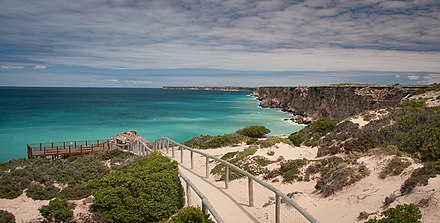Great Australian Bight Marine Park - group of marine protected areas in the Great Australian Bight
Great Australian Bight Marine Park is a large Australian marine park off the waters of South Australia. Although they may be off the waters of SA, most of the marine park is not part of South Australia but in Commonwealth waters, but for practical purposes, it is categorised under South Australia. Only the national park section is under the waters of South Australia, administered by the South Australia's National Parks and Wildlife Service.
For practical purposes, this article covers the larger Great Australian Bight Marine Park and not just the Commonwealth waters, and so the South Australian national park of Great Barrier Reef Marine National Park and the Great Australian Bight Marine Park Whale Sanctuary are covered under here. However, both of those now overlap with the Far West Coast Marine Park. With joint state and federal protection, the marine park is home to large populations of wales, sea lions, and perhaps one of the most extraordinary spots to find wildlife of the Southern Ocean.
The only visitor facilities of any kind are at the Head of the Bight.
Understand
History
The first European to come to the Great Australian Bight was in January 1627, when the Dutchman Pieter Nuyts sailed along the coast on the Gulde Zeepaard. Antoine Bruni d'Entrecasteaux later came to this area in December 1792 on the sailing ships La Recherche (French for "The research") and L'Esperence (French for "the Hope").
The first commercial activities in this sea area were carried out by whaling and sealing around 1800, which became insignificant after 1845 due to insufficient catches. From 1931, the whales in the South Australia area were placed under protection. The Southern Rock Lobster is also fished for.
In June 1995 the South Australian Government declared a 430 km² whale sanctuary. In 1996 another were placed under protection and the whole area was declared a marine park. In 1998, the federal government placed a further south of the marine park under protection as a marine park.
In November 2012, the Great Australian Bight Marine Park was incorporated into the Great Australian Bight Commonwealth Marine Reserve together with South Australia's parts and the newly created marine reserve covers . Since 2012, the marine reserve of the state of South Australia has been overlaid by the Far West Coast Marine Park, giving it the maximum protection.
Landscape
Flora and fauna
The area along the coast primarily protects Australian sea lions and southern right whales, while the south-facing deep-water strip protects benthos. The conservation park has a very rich marine fauna with a wide variety of marine animals such as red algae, sea squirts, bryozoans, mollusks and echinoderms. Many of these species are endemic.
The high food supply that attracts many animals to the sanctuary results from the meeting of the warm tropical waters of Western Australia and the cold waters of South Australia.
Climate
Visitor information centre
- Head of the Bight Visitor Centre, Unnamed Road, Yalata, -31.473688°, 131.113029°, +61 8 8625 6201. 8AM–5PM. Learn more about the whales that pass by the Nullabor. 2022-02-19
Park websites
Get in
Access is only via the Head of Bight visitor centre, which is a 20-minute deviation from the Eyre Highway. From there, access is restricted and you need a boat.
Fees and permits
You will need a permit if you want to do any of these things listed here. They can be applied for through environment.gov.au.
Get around
By boat is your only option.
See and do

- Perhaps while most marine parks don't have much to offer, Head of Bight has viewing platform to go whale watching (call +61 8 8625 6201 ). It is a much better option than going out on the very rough waters and the 100-metre cliffs. Your best bet for seeing whales are during June through to November
- Before 2017 when the introduction of drones were used to see these sea lions from 100-metre high cliffs, sea lions used to be a difficult sight
Buy, eat, drink and sleep
As you can imagine, you cannot buy something, or have some sort of picnic area or any eatery, bar or accommodation on water except on your own boat. The only infrastructure of any kind nearby is at the Head of Bight.
Stay safe
Note that the ocean cliffs are super tall. When diving and doing recreation activities, make sure to keep that in mind.
Go next
- Nullarbor Wilderness Protection Area is just up north on land
Great Australian Bight Marine Park
Timezone:MultipleCoordinates:-31.91, 131.44